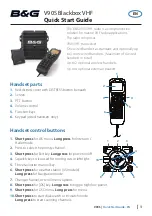
CMT2380F64
www. cmostek. com
Rev 0.3 | 18 / 83
90%
10%
V
LSEH
V
LSEL
t
r(LSE)
t
f(LSE)
T
LSE
t
W(LSE)
t
W(LSE)
t
External clock
source
OSC32_IN
f
LSE_ext
The AC timing diagram of the external low-speed clock source
⚫
A high-speed external clock generated by using a crystal / ceramic resonator
The high speed external clock (HSE) can be generated using an oscillator consisting of a 4
~
20 MHz crystal/ceramic
oscillator. The information given in this section is based on the use of typical external components listed in the table below. In
applications where the oscillator and load capacitance must be as close to the oscillator pin as possible to reduce output
distortion and stability time at startup. For detailed parameters of crystal oscillator (frequency, package, accuracy, etc.),
please consult the corresponding manufacturer (the crystal resonators mentioned here are usually referred to the passive
crystal oscillator).
HSE 4
~
20 MHz
Oscillator Characteristic
Symbol
Parameter
Condition
Min
Typ
Max
Unit
f
OSC_IN
Oscillator frequency
4
8
20
MHz
C
L1
C
L2
(3)
The suggested load capacitance and
corresponding crystal serial resistance
(
R
S
)
R
S
= 30
Ω
-
20
--
pF
i
2
HSE drive current
V
DD
=3.3 V, V
IN
=V
SS
30pF load
-
1.1
1.6
mA
t
SU(HSE)
(4)
Startup time
V
DD
is stable
3
ms
1.
The parameters of the resonator are given by the crystal resonator manufacturer.
2.
Guaranteed by design and comprehensive assessment, not tested in production.
3.
For CL1 and CL2, it is recommended to use high quality ceramic dielectric capacitance (typically) between 5pF and 25pF
designed for high-frequency applications, and to select suitable crystals or resonators. Usually CL1 and CL2 have the same
parameters. Crystal manufacturers usually give parameters for load capacitance as serial combinations of CL1 and CL2. The
capacitive reactance of PCB and MCU pins should be taken into account when selecting CL1 and CL2.
4.
tSU(HSE) is the startup time. It is measured from the time when HSE is enabled by software until a stable 8MHz oscillation is
obtained. This value is measured on a standard crystal resonator and can vary widely depending on the crystal manufacturer.
















































